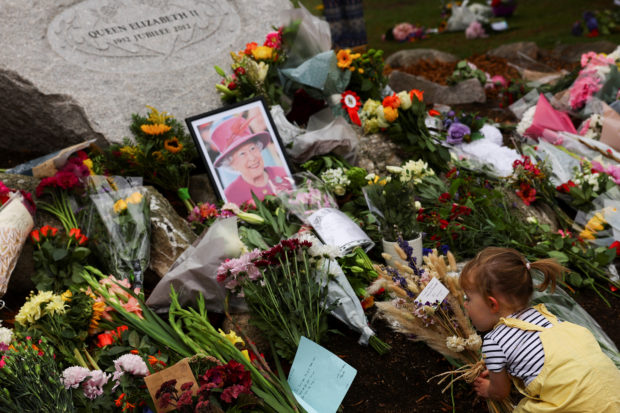
A kid places flowers in tribute near a monument, following the passing of Britain’s Queen Elizabeth, in Ballater, near Balmoral, Scotland, Britain, September 10, 2022. REUTERS FILE PHOTO
LONDON — Queen Elizabeth’s oak coffin began its journey from Balmoral Castle, her summer retreat in the Scottish Highlands, down to Edinburgh on Sunday, with thousands of Scots expected to line the streets to pay their respects.
Elizabeth, who died on Thursday aged 96, spoke last year of her “deep and abiding affection” for Scotland and recalled the “many happy memories” that she and her late husband Prince Philip shared in the country.
Below are some of her connections to Scotland:
Early life
The queen’s mother, also called Elizabeth, was from a Scottish family, who lived at Glamis Castle in Angus. As a young princess, Elizabeth spent most of her summers in Scotland either with her parents at Balmoral Castle or with her maternal grandparents at Glamis.
While still a teenager, she gave her first public speech in Aberdeen in 1944, when she opened a home for the British Sailors’ Society.
Postboxes
At the start of Elizabeth’s reign in 1952, there were objections in Scotland to her being called Elizabeth II because the Tudor Queen Elizabeth I was never a queen of Scotland.
A Post Office pillar box in Edinburgh bearing the ERII cypher was defaced and later blown up.
Balmoral
Queen Victoria and Prince Albert bought Balmoral Castle in 1852. Ever since then, the castle has been a base for the royal family’s summer vacations.
After acceding to the throne, Elizabeth maintained the royal family tradition of holidaying at Balmoral deep in the Scottish Highlands each summer.
Photographs over the decades showed the queen relaxing far from the pomp and pageantry of London, sometimes walking in the hills or having picnics with her family. Elizabeth’s granddaughter, Eugenie, said in 2016 TV documentary: “Granny is most happy there.”
The queen attended the Braemar Gathering, a celebration of traditional Scottish games, sports and dancing, every year she since came to the throne 70 years ago – apart from the games earlier this month that she missed because of failing health.
“She was very much part of life in this part of the world. Locals all have stories about bumping into her or seeing her at the Highland Games,” said Andrew Bowie, the Conservative member of parliament for West Aberdeenshire, which includes Balmoral. “She was hugely liked and respected. People felt a huge affinity to her.”
Scottish independence
Although the British monarch is meant to be politically neutral, the queen did hint at her views on the constitutional future of the country she reigned over.
In 1977, before a vote on the establishment of an assembly in Edinburgh and as she celebrated her Silver Jubilee, the monarch made a speech emphasizing how she was crowned the queen of all four nations.
“Perhaps this jubilee is a time to remind ourselves of the benefits which Union has conferred,” she said.
Just before a 2014 vote on Scottish independence, she was overheard expressing her wish that people “think very carefully about the future”.
The former Prime Minister David Cameron was later overheard saying Elizabeth had “purred” with happiness when he phoned her to inform her Scotland had voted to reject independence.
Scotland’s Parliament
Elizabeth formally opened the 129-member Scottish parliament in 1999, which gave Scotland the power to raise taxes and pass laws, and opened its new building in 2004.
While she is an advocate of Scottish independence, Scotland’s First Minister Nicola Sturgeon said after the queen’s death that Scotland “loved, respected and admired” her.
The queen’s admiration for Scotland was summed up in a speech to Scotland’s parliament last year.
“I have spoken before of my deep and abiding affection for this wonderful country,” she said. “It is the people that make a place and there are few places where this is truer than Scotland.”
RELATED STORIES
King Charles to fly to Scotland to join somber procession of Queen Elizabeth’s coffin
New monarch gives fresh impetus to Scotland’s independence debate